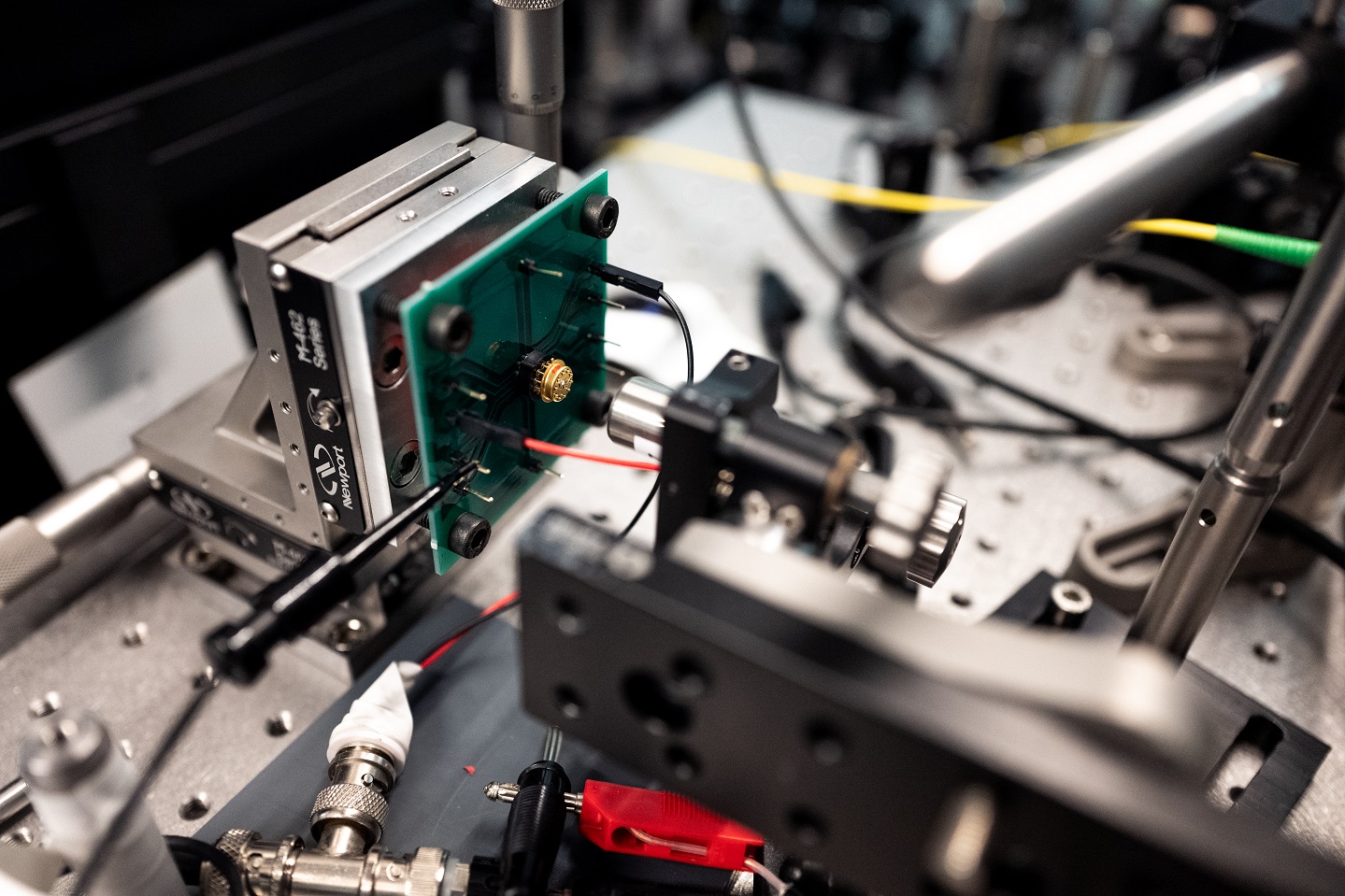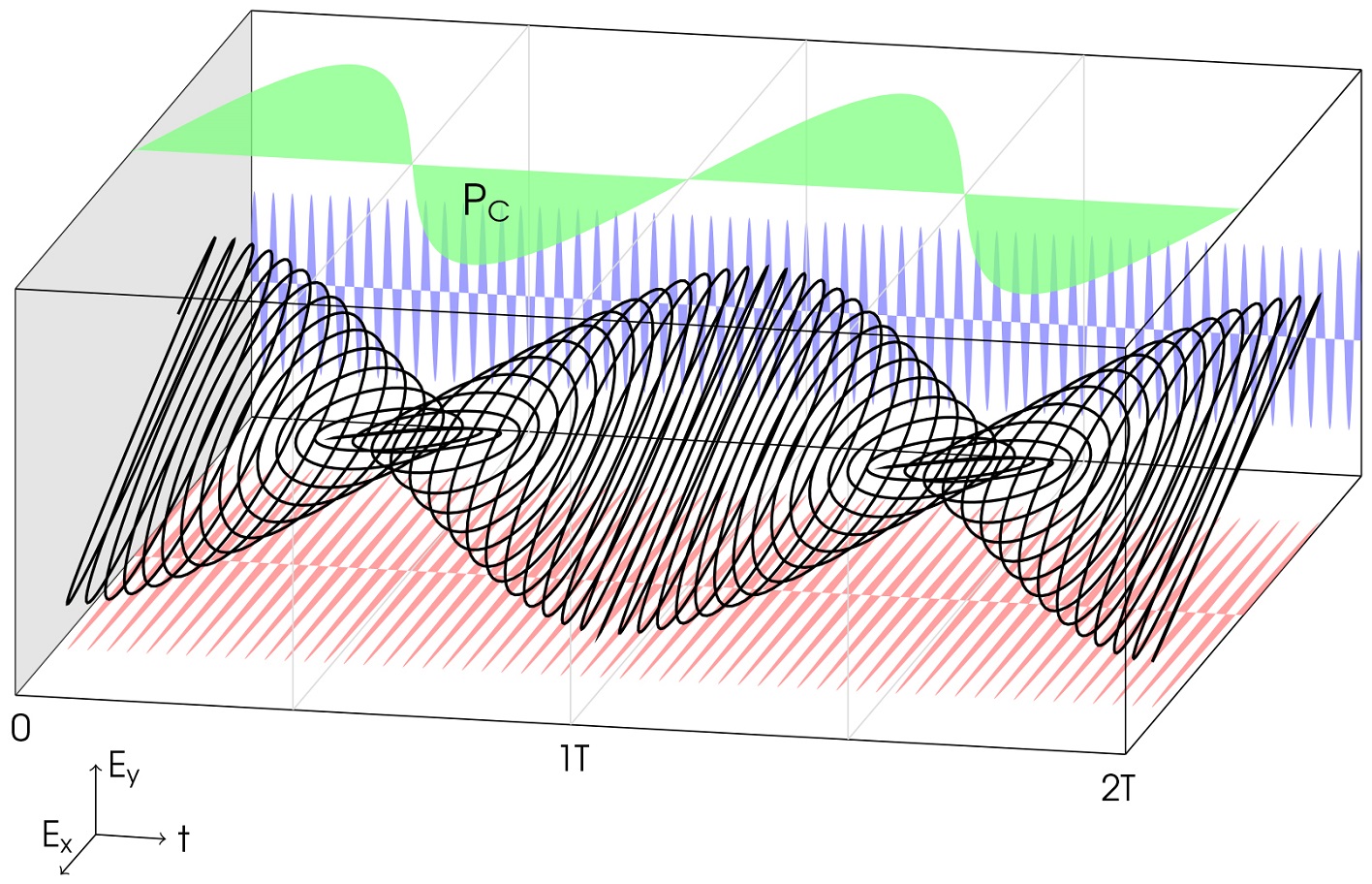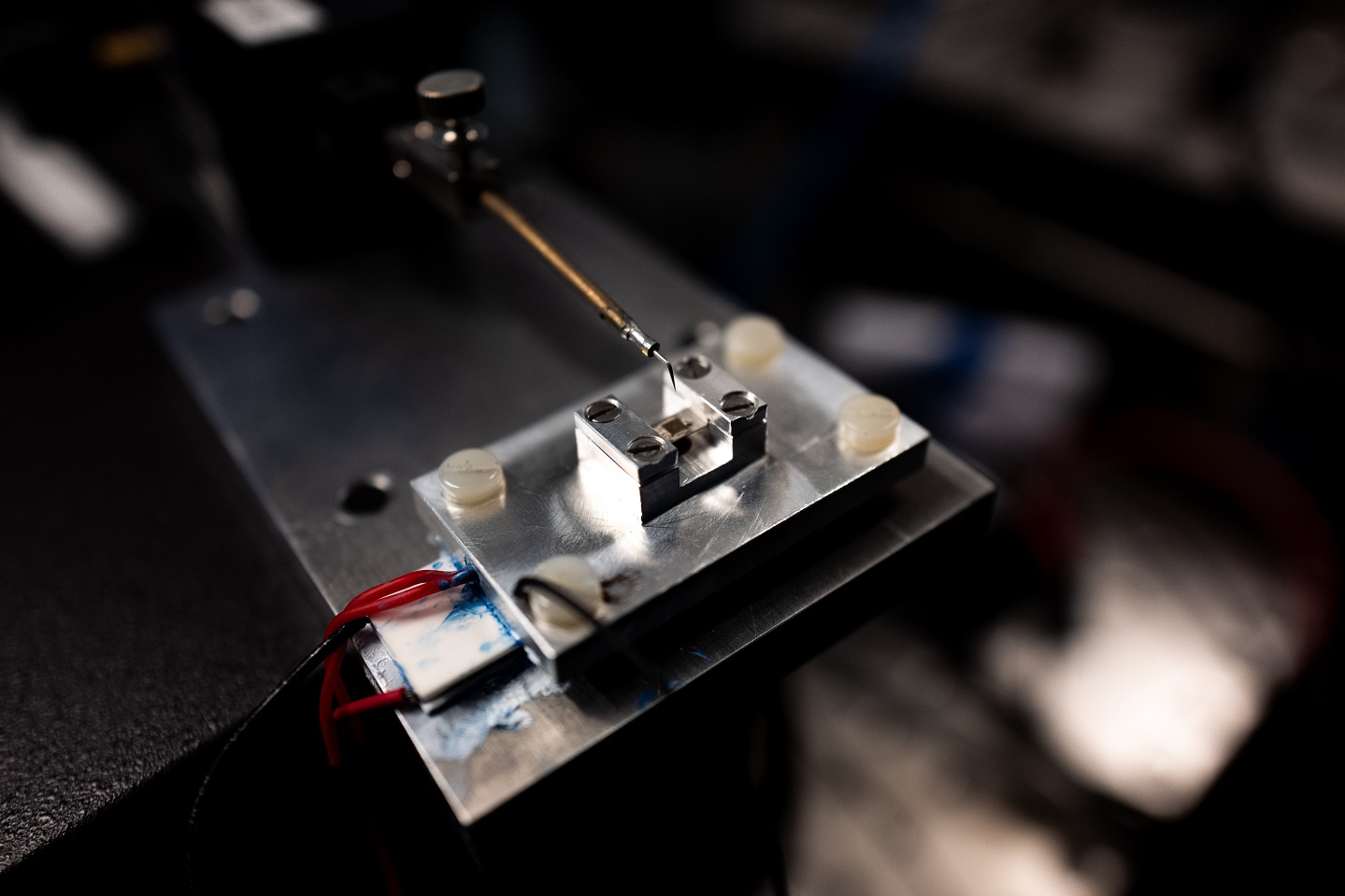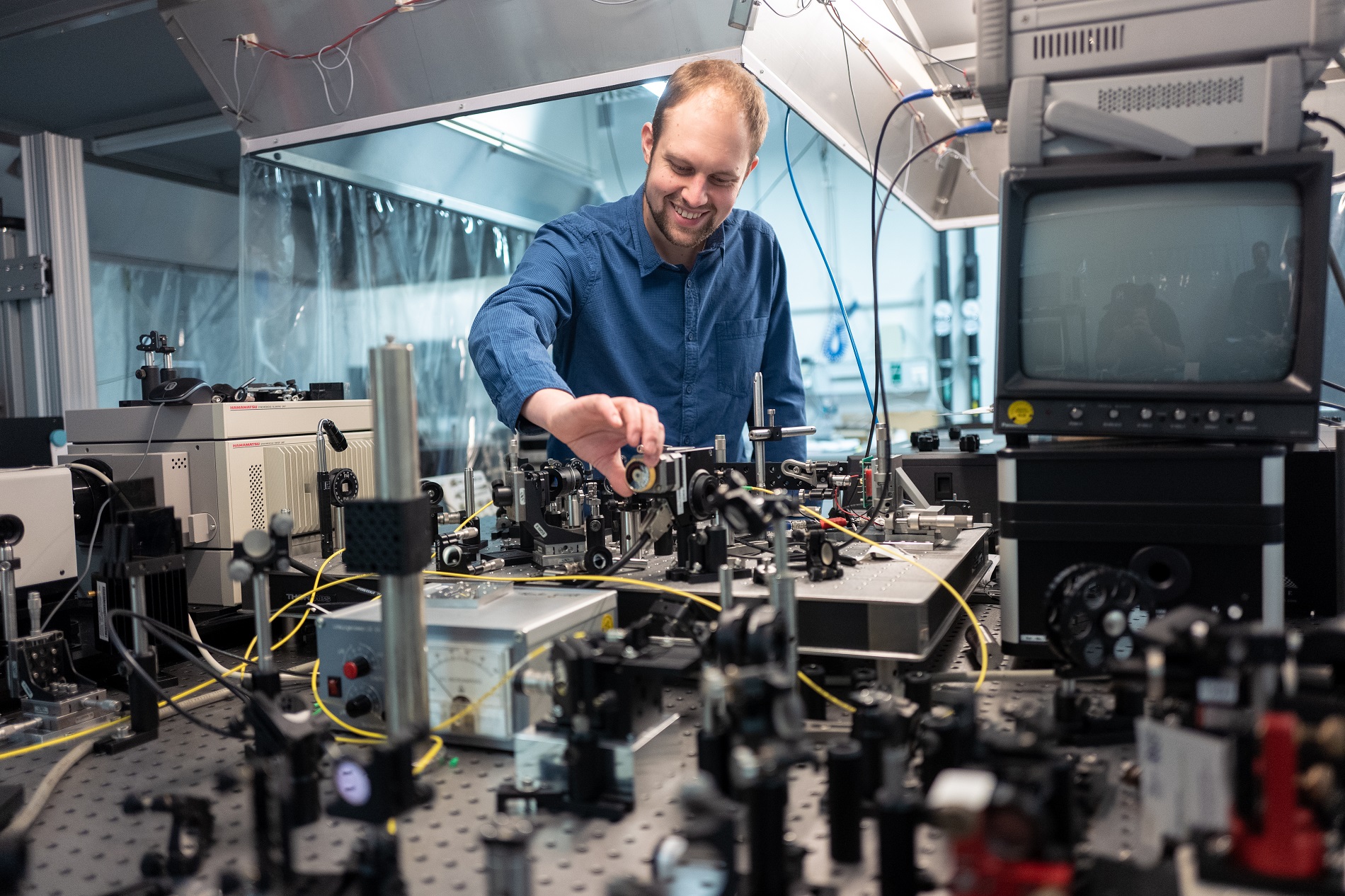4 April 2019
By Julia Weiler
Translated by Donata Zuber
So-called spin lasers may potentially accelerate data transfer in optical fibre cables to a considerable extent, while reducing energy consumption at the same time.
Engineers at Ruhr-Universität Bochum have developed a novel concept for rapid data transfer via optical fibre cables. In current systems, a laser transmits light signals through the cables and information is coded in the modulation of light intensity. The new system, a semiconductor spin laser, is based on a modulation of light polarisation instead. Published on 3 April 2019 in the journal “Nature”, the study demonstrates that spin lasers have the capacity of working at least five times as fast as the best traditional systems, while consuming only a fraction of energy. Unlike other spin-based semiconductor systems, the technology potentially works at room temperature and doesn’t require any external magnetic fields. The Bochum team at the Chair of Photonics and Terahertz Technology implemented the system in collaboration with colleagues from Ulm University and the University at Buffalo.

Spin lasers with integrated technology for electrically controlling the oscillation frequency
Photo credit: © RUB, Kramer
Rapid data transfer is currently an energy guzzler
Due to physical limitations, data transfer that is based on a modulation of light intensity without utilizing complex modulation formats can only reach frequencies of around 40 to 50 gigahertz. In order to achieve this speed, high electrical currents are necessary. “It’s a bit like a Porsche where fuel consumption dramatically increases if the car is driven fast,” compares Professor Martin Hofmann, one of the engineers from Bochum. “Unless we upgrade the technology soon, data transfer and the Internet are going to consume more energy than we are currently producing on Earth.” Together with Dr. Nils Gerhardt and PhD student Markus Lindemann, Martin Hofmann is therefore researching into alternative technologies.
Circularly polarised light as information carrier
Provided by Ulm University, the lasers, which are just a few micrometres in size, were used by the researchers to generate a light wave whose oscillation direction changes periodically in a specific way. The result is circularly polarised light that is formed when two linear perpendicularly polarised light waves overlap.
Oscillating circular polarisation
In linear polarisation, the vector describing the light wave’s electric field oscillates in a fixed plane. In circular polarisation, the vector rotates around the direction of propagation. The trick: when two linearly polarised light waves have different frequencies, the process results in oscillating circular polarisation where the oscillation direction reverses periodically – at a user-defined frequency of over 200 gigahertz.
Speed limit as yet undetermined
“We have experimentally demonstrated that oscillation at 200 gigahertz is possible,” describes Hofmann. “But we don’t know how much faster it can become, as we haven’t found a theoretical limit yet.”
The oscillation alone does not transport any information; for this purpose, the polarisation has to be modulated, for example by eliminating individual peaks. Hofmann, Gerhardt and Lindemann have verified in experiments that this can be done in principle. In collaboration with the team of Professor Igor Žutić and PhD student Gaofeng Xu from the University at Buffalo, they used numerical simulations to demonstrate that it is theoretically possible to modulate the polarisation and, consequently, the data transfer at a frequency of more than 200 gigahertz.
The generation of a modulated circular polarisation

The polarisation describes a light wave’s oscillation direction. Linear polarisation (red, blue): the vector describing the light wave’s electric field oscillates in a fixed plane. Circular polarisation can be described by a superposition of two linear perpendicularly polarised light waves. The electric field vector rotates around the propagation direction. If the frequencies of the overlapping fields are different, oscillating circular polarisation is the result (black). The circular polarisation degree (green) is modulated depending on the frequency difference. T is the cycle duration of this modulation.
Photo credit: © RUB, Lehrstuhl Photonik und Terahertztechnologie
Two factors are decisive in order to generate a modulated circular polarisation degree: the laser has to be operated in a way that it emits two perpendicular linearly polarised light waves simultaneously, the overlap of which results in circular polarisation. Moreover, the frequencies of the two emitted light waves have to differ enough to facilitate high-speed oscillation.
The laser light is generated in a semiconductor crystal, which is injected with electrons and electron holes. When they meet, light particles are released. The spin – an intrinsic form of angular momentum – of the injected electrons is indispensable in order to ensure the correct polarisation of light. Only if the electron spin is aligned in a certain way, the emitted light has the required polarisation – a challenge for the researchers, as spin alignment changes rapidly. This is why the researchers have to inject the electrons as closely as possible to the spot within the laser where the light particle is to be emitted. Hofmann’s team has already applied for a patent with their idea of how this can be accomplished using a ferromagnetic material.

Spin lasers whose oscillation frequency can be mechanically controlled via the mount. Electrical contact can be made via an adjustable needle.
Photo credit: © RUB, Kramer
Frequency difference through double refraction
The frequency difference in the two emitted light waves that is required for oscillation is generated using a technology provided by the Ulm-based team headed by Professor Rainer Michalzik. The semiconductor crystal used for this purpose is birefringent. Accordingly, the refractive indices in the two perpendicularly polarised light waves emitted by the crystal differ slightly. As a result, the waves have different frequencies. By bending the semiconductor crystal, the researchers are able to adjust the difference between the refractive indices and, consequently, the frequency difference. That difference determines the oscillation speed, which may eventually become the foundation of accelerated data transfer.
“The system is not ready for application yet,” concludes Martin Hofmann. “The technology has still to be optimised. By demonstrating the potential of spin lasers, we wish to open up a new area of research.”
Funding
The study was financed by the German Research Foundation with grants no. GE1231/2-2 and MI607/9-2, the US American National Science Foundation (grants no. ECCS-1508873 and ECCS-1810266) and the Office of Naval Research (grant no. 000141712793).
Original publication
Markus Lindemann, Gaofeng Xu, Tobias Pusch, Rainer Michalzik, Martin R. Hofmann, Igor Žutić, Nils C. Gerhardt: Ultrafast spin-lasers, in: Nature, 2019, DOI: 10.1038/s41586-019-1073-y, freely available PDF version














